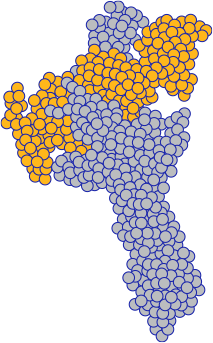Our Approach
Our approach enables more precise targeting designed to
result in effective treatments.
Adastra is developing a small-molecule multi-kinase inhibitor possessing designed affinity to several tumor-enabling kinase pathways such as cyclin-dependent kinase 9 (CDK9). The inhibitory activity at CDK9 interrupts RNA polymerase II synthesis of the short live protein MYC, a key oncogenic mutational driver. MYC is a ubiquitous oncogene that is frequently overexpressed in cancer cells.1-3


More than 80% of high-grade gliomas overexpress MYC.4 This oncogenic protein increases the surface expression of glutamine transporters and alters mitochondrial metabolism.5 A focus of the Adastra clinical development program is high-grade gliomas that have demonstrated overexpression of MYC with glucose reliance and glutamine metabolism dependency.
Adastra: An Optimized Approach in Addressing the Challenges of Drug Development
CHALLENGES

ADASTRA APPROACH
Tumor Heterogeneity
There are a multiplicity of tumor-driving genetic aberrations and many are implicated in gliomas.
There are a multiplicity of tumor-driving genetic aberrations and many are implicated in gliomas.

Rational Target Selection4
Adastra is utilizing a rational and targeted approach in the depletion of an oncogenic protein that is overexpressed in 80% of high-grade gliomas.
Adastra is utilizing a rational and targeted approach in the depletion of an oncogenic protein that is overexpressed in 80% of high-grade gliomas.
Heterogenous Clinical Population
There are many distinct patient subtypes within glioma, segmented by histology, molecular profile, and cell type.
There are many distinct patient subtypes within glioma, segmented by histology, molecular profile, and cell type.

Enriched Patient Population
At Adastra, our development plans strive to identify enriched patient populations.
At Adastra, our development plans strive to identify enriched patient populations.
Treatment-Resistance Mechanisms
Tumors are fast to evolve; they possess many compensatory mechanisms and develop resistance to single-agent approaches.
Tumors are fast to evolve; they possess many compensatory mechanisms and develop resistance to single-agent approaches.

Multiple and Globally Impactful Pharmacological Targets
Through the inhibition of multiple CDK isoforms, the Adastra lead compound affects global transcription regulation, while also impacting the ERK pathway.
Through the inhibition of multiple CDK isoforms, the Adastra lead compound affects global transcription regulation, while also impacting the ERK pathway.
Drug Delivery
It is essential that enough of the drug is delivered to tumor sites. This is a challenging proposition with gliomas, because of the logistical hurdle of the blood-brain barrier.
It is essential that enough of the drug is delivered to tumor sites. This is a challenging proposition with gliomas, because of the logistical hurdle of the blood-brain barrier.

Tissue Penetration
The Adastra lead compound has demonstrated an optimized balance of lipo- and hydrophilicity, achieving meaningful systemic blood levels, for example, in high-grade gliomas the ability to cross the blood-brain barrier.
The Adastra lead compound has demonstrated an optimized balance of lipo- and hydrophilicity, achieving meaningful systemic blood levels, for example, in high-grade gliomas the ability to cross the blood-brain barrier.
Toxicity
Potent anticancer drugs are often associated with toxicity.
Potent anticancer drugs are often associated with toxicity.

Favorable Safety Profile
Adverse events should not prevent compliance to effective cancer therapies.
Adverse events should not prevent compliance to effective cancer therapies.
Use of standard genetic screening helps to identify key driver mutations and enables a targeted approach